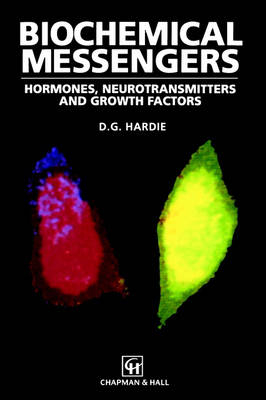
Biochemical Messengers: Hormones, Neurotransmitters and Growth Factors
Chapman and Hall (Verlag)
978-0-412-30350-0 (ISBN)
Introduction - cell-to-cell signalling by bridges: why do cells need to communicate?; three basic types of intracellular signalling; intracellular signalling via cytoplasmic bridges. Part 1 The first messengers - hormones, neurotransmitters and local mediators: hormones; neurotransmitters; local mediators (paracrine control). Part 2 Structure and biosynthesis of first messengers: messengers derived from amino acids and other water soluble metabolites; messengers sunthesized from lipids; peptide messengers. Part 3 Ionic homeostasis and nervous conduction: ionic homeostasis; excitable cells and nervous conduction. Part 4 Cell biology of first messenger synthesis and secretion: cell biology of peptide messenger synthesis; import of non-peptide messengers into secretory granules; triggering of exocytosis. Part 5 Cell surface receptors - analysis and identification: receptor binding studies; identification and characterization of receptor proteins; receptor superfamilies; desensitization of receptors; down-regulation of receptors. Part 6 Cell surface receptors - signal transduction: ligand-gated ion channels; second messenger systems - cyclic nucleotides; Ca2+-mobilizing messengers utilize a novel second messenger system; receptors with integral enzyme activity. Part 7 Cell surface receptors - protein phosphorylation and other intracellular events: responses to depolarization by ligand-gated ion channels; responses to Ca2+ and second messengers; responses to protein (Tyrosine) kinase receptors; protein phosphatases; how does phosphorylation modulate protein function?; advantages of protein phosphorylation for signal transduction. Part 8 Regulation of cell proliferation and cancer: growth of normal and abnormal cells in culture; discovery of oncogenes; functions of oncogenes and their normal counterparts; the anti-oncogenes tumour suppressors; mutation of more than one gene may be necessary to produce cancer. Part 9 Signal transduction by nuclear receptors: nuclear receptors bind directly to target genes; anatomy of nuclear receptors; mechanism of gene activastion.
| Erscheint lt. Verlag | 1.5.1991 |
|---|---|
| Zusatzinfo | X, 312 p. |
| Verlagsort | London |
| Sprache | englisch |
| Maße | 156 x 234 mm |
| Themenwelt | Naturwissenschaften ► Biologie ► Biochemie |
| Naturwissenschaften ► Biologie ► Mikrobiologie / Immunologie | |
| Naturwissenschaften ► Biologie ► Zellbiologie | |
| ISBN-10 | 0-412-30350-7 / 0412303507 |
| ISBN-13 | 978-0-412-30350-0 / 9780412303500 |
| Zustand | Neuware |
| Haben Sie eine Frage zum Produkt? |
aus dem Bereich


